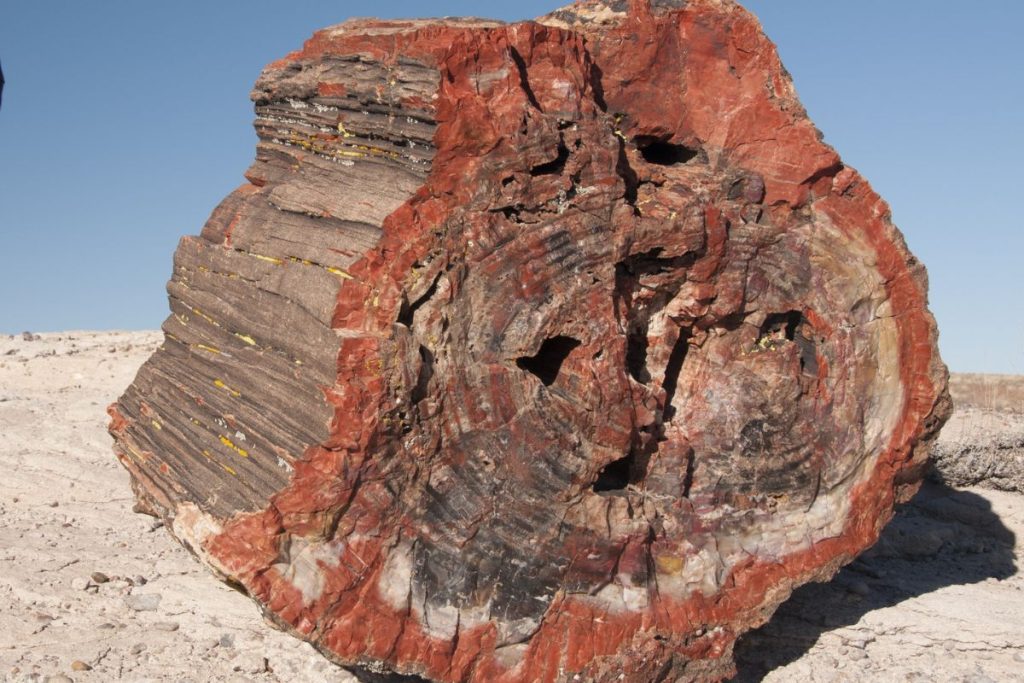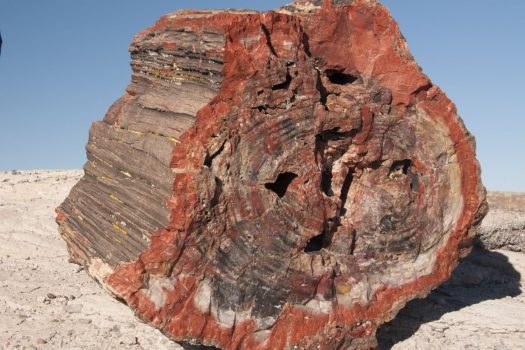Contents
If you hike often or spend a significant amount of time in nature, chances are that you have stumbled upon a strange but unique gemstone that looks like a piece of wood but feels more like a rock.
If you’ve found something like this before, you’ve probably found petrified wood.

Petrified wood is essentially wood that has become fossilized over time as the organic materials within them have been replaced by minerals while the natural structures and stems have been preserved.
There are many different types of petrified wood, but identifying whether something is petrified wood is something that can be done by anyone with the right tips.
In this article, we will look at how to identify petrified wood by eye or with a magnifying glass.
Determining If Your Specimen Is Petrified Wood
One of the easiest ways to determine whether your specimen is petrified wood or not is by eye.
This process can be done right when you find the specimen rather than waiting until you are at home or somewhere with access to a magnifying glass or microscope.
There are a few simple features and characteristics to look for to ascertain whether you have a rock or petrified wood.
Look For Smooth Textures
The first step in identifying petrified wood is to look for smooth textures on the specimen. Petrified wood that has smooth textures is one of the easiest to identify, however, not all specimens will have smooth textures on them.
If your sample does have a smooth texture on it, you should look for evidence of sap or standard sap colors such as red, orange, or tan that surround the smooth area.
The area of the specimen that has a smooth texture to it is generally going to be between 3 to 5 inches long depending on the size of the specimen.
One of the most obvious signs of petrified wood is the appearance and feel of wood, but with no bark on it.
The smooth textures can be indicative of petrified wood but without the wood patterns and appearance, it can be difficult to tell. You can search the specimen for jagged areas that denote where it broke off from its tree.
Check For Transparency
Another way to help identify petrified wood is by holding it up to the light. Many pieces of petrified wood are transparent, if you are struggling to tell whether your specimen is transparent because it is a darker brown color, simply holding it up to the light can help you decipher whether it is at all transparent or not.
The whole piece of petrified wood doesn’t have to be transparent, just a few parts of it. Some specimens may be so transparent that you can see the outline of your fingers through them.
Check For Thick Sections Of White
Another tell-tale sign of petrified wood is thick sections of white color in the specimen. These sections are areas of dried-out sap that was once in the wood.
Most commonly, these sections are around half an inch thick. If these areas of dried sap are close to the smooth areas that look like bark or the areas that are colored like sap, it is even more likely that what you have found is petrified wood.
You can also hold the white areas up to the light to check for transparency as these areas are much more likely to be transparent than the darker areas due to their coloring.
Look For Circular, Grainy, Or Bark-Like Patterns
In many cases, the original cell structure of the petrified wood has been destroyed over the years, and therefore, it can be difficult to identify the specimen as wood at all.
You can, however, use your naked eye to help look for patterns such as circles, grains, and anything else that bears a resemblance to bark.
It is these patterns that can help you know whether you are holding petrified wood or not. If you are able to identify any sort of pattern on your specimen, it means that the cell structure is still somewhat intact and therefore, the type of wood can be identified.
Using A Microscope Or Magnifying Glass

If you are unsure about identifying the specimen where you found it or you simply didn’t have time, you can take it home and look at it under a microscope or a magnifying glass to get a closer look.
Check For Small Round Cells Or Rod-Like Structures
The first thing that you should look for is small round cells or rod-like structures. These characteristics are caused by tracheids.
For some of these cells and patterns to be visible you may only need a 10X magnification, however, others may require up to 800X magnification.
Specimens that require 800X magnification may be out of your range. The best method is to start with a low magnification and keep increasing until you can identify the structures.
Examine Thickness And Variation Of Rays
Rays in this scenario refer to lines that are formed by small cells that run radially from the center to the outer edge of the tree.
Some trees will feature very thin rays of around 1 – 2 cells wide, whereas others can have rays that are much thicker. Once you have discovered how thick the rays are, you can match them to different types of trees.
Identify Trace Elements Of Minerals
Although you cannot identify the specific minerals or type of wood through the colors of the wood specimen, they can be useful for identifying the trace elements that are present.
You can make a note of the different hues that are visible in your specimen to later match to the corresponding elements.
Final Thoughts
There are multiple ways to identify whether what you have found is petrified wood and even to determine which type of wood it is.
The identification of the specific type of wood requires a microscope in order to get accurate information about the structural makeup of the wood.







